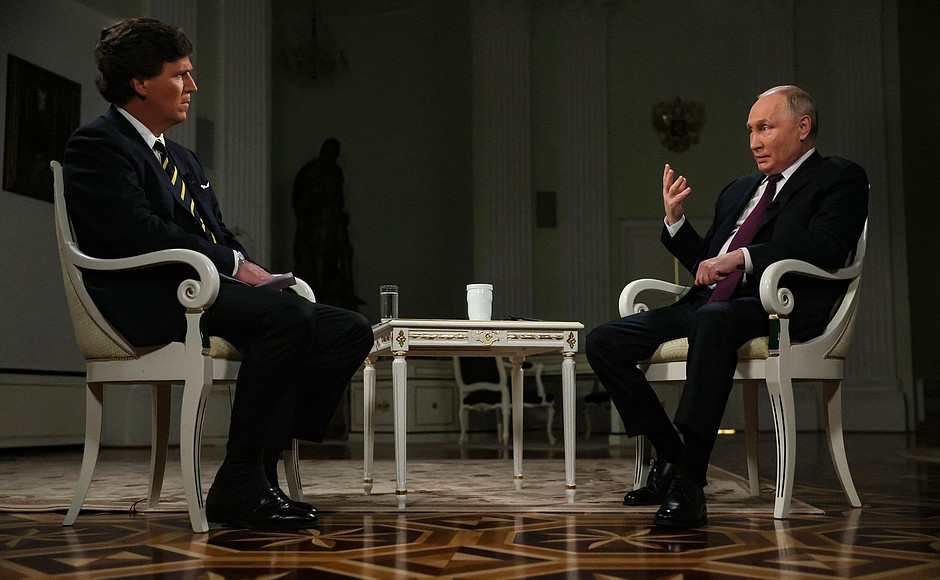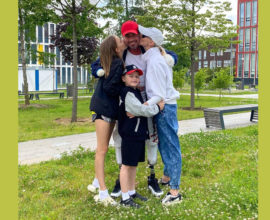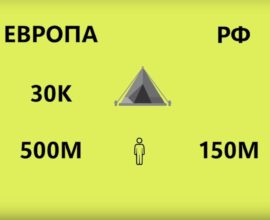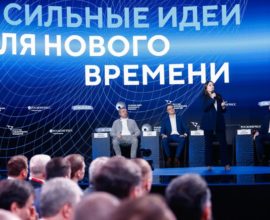EN-RU Exclusive: Tucker Carlson interviews Vladimir Putin, President of Russia
Exclusive EN-RU parallel translation: Tucker Carlson interviews Vladimir Putin, President of Russia // Эксклюзив EN-RU параллельный перевод: Такер Карлсон берет интервью у Владимира Путина, Президента России
09/02/2024
| EN
Tucker Carlson: Mr. President, thank you. On February 22, 2022, you addressed your country in your nationwide address when the conflict in Ukraine started and you said that you were acting because you had come to the conclusion that the United States through NATO might initiate a quote, “surprise attack on our country”. And to American ears that sounds paranoid. Tell us why you believe the United States might strike Russia out of the blue. How did you conclude that? Tucker Carlson: That was a good quote. Thank you, it’s formidably serious! Vladimir Putin: You were initially trained in history, as far as I know? Tucker Carlson: Yes. Vladimir Putin: So if you don’t mind I will take only 30 seconds or one minute of your time for giving you a little historical background. Tucker Carlson: Please. Vladimir Putin: Let’s look where our relationship with Ukraine started from. Where does Ukraine come from? The Russian state started to exist as a centralized state in 862. This is considered to be the year of creation of the Russian state because this year the townspeople of Novgorod (a city in the North-West of the country) invited Rurik, a Varangian prince from Scandinavia, to reign. In 1862, Russia celebrated the 1000th anniversary of its statehood, and in Novgorod there is a memorial dedicated to the 1000th anniversary of the country. In 882, Rurik’s successor Prince Oleg, who was, actually, playing the role of regent at Rurik’s young son because Rurik had died by that time, came to Kiev. He ousted two brothers who, apparently, had once been members of Rurik’s squad. So, Russia began to develop with two centers of power, Kiev and Novgorod. The next, very significant date in the history of Russia, was 988. This was the Baptism of Russia, when Prince Vladimir, the great-grandson of Rurik, baptized Russia and adopted Orthodoxy, or Eastern Christianity. From this time the centralized Russian state began to strengthen. Why? Because of a single territory, integrated economic ties, one and the same language and, after the Baptism of Russia, the same faith and rule of the Prince. The centralized Russian state began to take shape.
Back in the Middle Ages, Prince Yaroslav the Wise introduced the order of succession to the throne, but after he passed away, it became complicated for various reasons. The throne was passed not directly from father to eldest son, but from the prince who had passed away to his brother, then to his sons in different lines. All this led to the fragmentation and the end of Rus as a single state. There was nothing special about it, the same was happening then in Europe. But the fragmented Russian state became an easy prey to the empire created earlier by Genghis Khan. His successors, namely, Batu Khan, came to Rus, plundered and ruined nearly all the cities. The southern part, including Kiev, by the way, and some other cities, simply lost independence, while northern cities preserved some of their sovereignty. They had to pay tribute to the Horde, but they managed to preserve some part of their sovereignty. And then a unified Russian state began to take shape with its centre in Moscow. The southern part of the Russian lands, including Kiev, began to gradually gravitate towards another ”magnet“ – the centre that was emerging in Europe. This was the Grand Duchy of Lithuania. It was even called the Lithuanian-Russian Duchy, because Russians were a significant part of its population. They spoke the Old Russian language and were Orthodox. But then there was a unification, the union of the Grand Duchy of Lithuania and the Kingdom of Poland. A few years later, another union was signed, but this time already in the religious sphere. Some of the Orthodox priests became subordinate to the Pope. Thus, these lands became part of the Polish-Lithuanian state. During decades, the Poles were engaged in the ”Polonization“ of this part of the population: they introduced their language there, tried to entrench the idea that this population was not exactly Russians, that because they lived on the fringe (u kraya) they were “Ukrainians”. Originally, the word ‘Ukrainian’ meant that a person was living on the outskirts of the state, near the fringe, or was engaged in border service. It didn’t mean any particular ethnic group. So, the Poles were trying in every possible way to polonize this part of the Russian lands and actually treated it rather harshly, not to say cruelly. All that led to the fact that this part of the Russian lands began to struggle for their rights. They wrote letters to Warsaw demanding that their rights be observed and that people be commissioned here, including to Kiev… Tucker Carlson: I beg your pardon, can you tell us what period… I am losing track of where in history we are?
Vladimir Putin: It was in the 13th century. Now I will tell what happened later and give the dates so that there is no confusion. And in 1654, even a bit earlier, the people who were in control of the authority over that part of the Russian lands, addressed Warsaw, I repeat, demanding their rights be observed that they send to them rulers of Russian origin and Orthodox faith. When Warsaw did not answer them and in fact rejected their demands, they turned to Moscow so that Moscow took them away. So that you don’t think that I am inventing things… I’ll give you these documents… Tucker Carlson: It doesn’t sound like you are inventing it, but I am not sure why it’s relevant to what’s happened two years ago. Vladimir Putin: But still, these are documents from the archives, copies. Here are letters from Bogdan Khmelnitsky, the man who then controlled the power in this part of the Russian lands that is now called Ukraine. He wrote to Warsaw demanding that their rights be upheld, and after being refused, he began to write letters to Moscow asking to take them under the strong hand of the Moscow Tsar. There are copies of these documents. I will leave them for your good memory. There is a translation into Russian, you can translate it into English later. Russia would not agree to admit them straight away, assuming this would trigger a war with Poland. Nevertheless, in 1654, the Zemsky Sobor, which was a representative body of power of the Old Russian state, made the decision: those Old Russian lands became part of the Tsardom of Muscovy.
As expected, the war with Poland began. It lasted 13 years, and then a truce was concluded. In all, after that act of 1654, 32 years later, I think, a peace treaty with Poland was concluded, “the eternal peace,” as it said. And those lands, the whole left bank of the Dnieper, including Kiev, reverted to Russia, while the entire right bank of the Dnieper remained in possession of Poland. Under the rule of Catherine the Great, Russia reclaimed all of its historical lands, including in the south and west. This all lasted until the Revolution. Before World War I, Austrian General Staff relied on the ideas of Ukrainianization and started actively promoting the ideas of Ukraine and the Ukrainianization. Their motive was obvious. Just before World War I they wanted to weaken the potential enemy and secure themselves favourable conditions in the border area. So the idea which had emerged in Poland that people residing in that territory were allegedly not really Russians, but rather belonged to a special ethnic group, Ukrainians, started being propagated by the Austrian General Staff. As far back as the 19th century, theorists calling for Ukrainian independence appeared. All those, however, claimed that Ukraine should have a very good relationship with Russia. They insisted on that. After the 1917 Revolution, the Bolsheviks sought to restore the statehood, and the Civil War began, including the hostilities with Poland. In 1921, peace with Poland was proclaimed, and under that treaty, the right bank of the Dnieper River once again was given back to Poland… |
RU
Т.Карлсон (как переведено): Господин Президент, спасибо большое. 24 февраля 2022 года Вы обратились к своей стране и нации, когда начался конфликт на Украине. Вы сказали, что действуете, потому что пришли к выводу, что с помощью НАТО США могут начать внезапную атаку, нападение на вашу страну. Для американцев это подобно паранойе.Почему Вы считаете, что Америка могла нанести неожиданный удар по России? Как Вы пришли к такому выводу? В.Путин: Дело не в том, что Америка собиралась наносить неожиданный удар по России, я так и не говорил. У нас с Вами ток-шоу или у нас серьёзный разговор? Т.Карлсон: Это прекрасная цитата. Спасибо.У нас серьёзный разговор. В.Путин: У Вас базовое образование историческое, насколько я понимаю, да? Т.Карлсон: Да. В.Путин: Тогда я позволю себе – просто 30 секунд или одну минуту – маленькую историческую справку дать. Вы не против? Т.Карлсон: Пожалуйста, конечно. В.Путин: Смотрите, с чего начались наши отношения с Украиной, откуда она взялась, Украина? Российское государство стало собираться как централизованное, это считается годом создания Российского государства – 862 год, когда новгородцы – есть такой город Новгород на северо-западе страны – пригласили на княжение князя Рюрика из Скандинавии, из варягов. 862 год. В 1862 году Россия отмечала 1000-летие своей государственности, и в Новгороде стоит памятник, посвящённый 1000-летию страны. В 882 году преемник Рюрика, князь Олег, который выполнял, по сути, функции регента при малолетнем сыне Рюрика, а Рюрик умер к этому времени, пришёл в Киев. Отстранил от власти двух братьев, которые, судя по всему, были когда-то членами дружины Рюрика, и, таким образом, Россия начала развиваться, имея два центра: в Киеве и в Новгороде. Следующая, очень значимая дата в истории России, – 988 год. Это Крещение Руси, когда князь Владимир, это правнук Рюрика, крестил Русь и принял православие – восточное христианство. С этого времени начало укрепляться централизованное Российское государство. Почему? Единая территория, единые хозяйственные связи, один язык и после крещения Руси – одна вера и власть князя. Начало складываться централизованное Российское государство. Но в силу разных причин после введения престолонаследия – тоже в древние времена, Средние века – Ярославом Мудрым, чуть-чуть попозже, после того как он ушёл из жизни, престолонаследие было сложным, передавалось не напрямую от отца к старшему сыну, а от ушедшего из жизни князя его брату, потом сыновьям по разным линиям. Всё это привело к раздробленности Руси – единого государства, которое начало складываться как единое. Ничего особенного в этом нет, то же самое происходило в Европе. Но раздробленное Русское государство стало лёгкой добычей той империи, которую создал когда-то Чингисхан. Его преемники, хан Батый, пришли на Русь, разграбили практически все города, разорили их. Южная часть, где был Киев, кстати говоря, некоторые другие города, они просто утратили самостоятельность, а северные города сохранили часть своего суверенитета. Платили дань в Орду, но часть суверенитета сохранили. А потом с центром в Москве начало складываться единое Российское государство. Южная часть русских земель, включая Киев, начала постепенно тянуться к другому «магниту» – к тому центру, который складывался в Европе. Это было Великое Литовское княжество. Его даже называли Литовско-Русское, потому что русские составляли значительную часть этого государства. Они разговаривали на древнерусском языке, были православными. Но затем произошло объединение – уния Великого княжества Литовского и Польского королевства. Спустя несколько лет ещё одна уния была подписана уже в духовной сфере, и часть православных священников подчинилась власти Папы Римского. Таким образом, вот эти земли оказались в составе Польско-Литовского государства. Но поляки в течение десятилетий занимались ополячиванием этой части населения: внедряли туда свой язык, стали внедрять идею о том, что это не совсем русские, что, поскольку они живут у края, они украинцы. Первоначально слово «украинец» означало, что человек живёт на окраине государства, “у края», или занимается пограничной службой, по сути дела. Это не означало какой-то особой этнической группы. Так вот, поляки всячески ополячивали и в принципе относились к этой части русских земель достаточно жёстко, если не сказать жестоко. Всё это привело к тому, что эта часть русских земель начала бороться за свои права. И писали письма в Варшаву, требуя соблюдения своих прав, с тем чтобы сюда присылали, в том числе в Киев, людей… Т.Карлсон: Простите, что перебиваю, можете сказать период когда это было, в какие годы? В.Путин: Это было в XIII (13-м) веке. Я сейчас скажу, что было дальше, и назову даты, чтобы не было путаницы. И в 1654 году, чуть раньше даже, – люди, которые контролировали власть в этой части русских земель, обращались в Варшаву, повторяю, с требованием, чтобы к ним присылали людей русского происхождения и православного вероисповедания. А когда Варшава им в принципе ничего не ответила и практически как бы отвергла эти требования, они начали обращаться в Москву, чтобы Москва их забрала к себе. Чтобы Вы не думали, что я что-то придумал, я Вам отдам вот эти документы… Т.Карлсон: Я не думаю, что Вы что-то выдумываете, нет, но я не уверен, почему это имеет отношение к тому, что произошло два года назад В.Путин: И всё-таки – это документы из архива, копии. Здесь письма Богдана Хмельницкого, тогда человека, который контролировал власть в этой части русских земель, которые мы сейчас называем Украиной. Он писал в Варшаву с требованием соблюдения их прав, а после того, как получил отказ, начал писать письма в Москву с просьбой взять их под сильную руку московского царя. Здесь [в папке] копии этих документов. Я Вам их оставлю на добрую память. Там есть перевод на русский, потом переведёте на английский язык. Россия не соглашалась их принимать сразу, потому что исходила из того, что начнётся война с Польшей. Всё-таки в 1654 году Земским собором – это был представительный орган власти Древнерусского государства – решение было принято: эта часть древнерусских земель вошла в состав Московского царства. Как и предполагалось, началась война с Польшей. Она шла 13 лет, потом было заключено перемирие. А всего после заключения этого акта 1654 года через 32, по-моему, года был заключён мир с Польшей, «вечный мир», как тогда было сказано. И эти земли, всё левобережье Днепра, включая Киев, отошли к России, а всё правобережье Днепра осталось за Польшей. Затем во времена Екатерины II Россия вернула все свои исторические земли, включая юг и запад. Это всё продолжалось до революции. А перед Первой мировой войной, воспользовавшись этими идеями украинизации, австрийский генеральный штаб очень активно начал продвигать идею Украины и украинизации. Всё понятно для чего: потому что в преддверии мировой войны, конечно, было стремление ослабить потенциального противника, было стремление создать себе благоприятные условия в приграничной полосе. И эта идея, родившаяся когда-то в Польше, что люди, проживающие на этой территории, не совсем русские, они якобы особая этническая группа, украинцы, начала продвигаться и австрийским генеральным штабом. Возникли и теоретики независимости Украины уже в XIX веке, которые говорили о необходимости независимости Украины. Но, правда, все эти «столпы» украинской независимости говорили о том, что она должна иметь очень хорошие отношения с Россией, они на этом настаивали. Тем не менее после революции 1917 года большевики старались восстановить государственность, развернулась Гражданская война, в том числе и [война] с Польшей. Был подписан мир с Польшей в 1921 году, по которому западная часть, на правом берегу Днепра, опять отошла к Польше.. |
Read the full script in English – http://en.kremlin.ru/events/president/news/73411
Полная расшифровка интервью на русском – http://www.kremlin.ru/events/president/news/73411
Tucker Carlson: Interview with President of Russia Vladimir Putin (part 1 history) English subtitles (subs should be available during or after stream)
With Russian subtitles for a more understandable translation of the interview into English // С русскими субтитрами для более понятного перевода интервью на английский
More articles from the website // Больше статей с сайта:
https://englishmag.ru/ru/vladimir-city-and-its-history/





